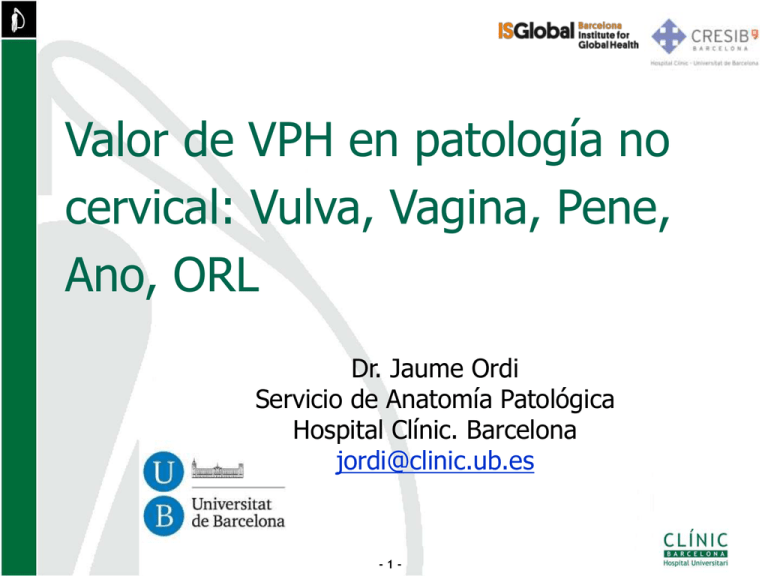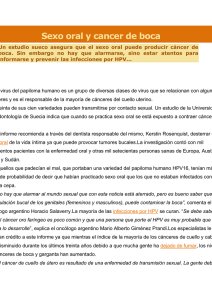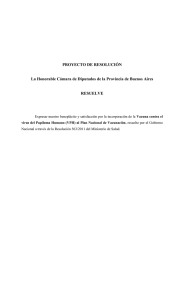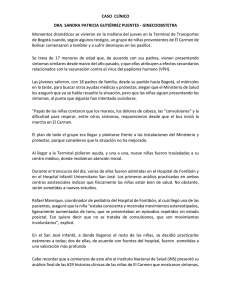Valor de VPH en patología no cervical: Vulva, Vagina, Pene, Ano, ORL
Anuncio

Valor de VPH en patología no cervical: Vulva, Vagina, Pene, Ano, ORL Dr. Jaume Ordi Servicio de Anatomía Patológica Hospital Clínic. Barcelona [email protected] -1- Neoplasias asociadas a HPV Cervix Forman D, et al. Vaccine 2012; 30 Suppl 5. F12-F23 -2- Neoplasias asociadas a HPV -3- Neoplasias asociadas a HPV • Cérvix • Vulva • Vagina • Pene • Ano • Región ORL • Conjuntiva • Piel -4- Neoplasias asociadas a HPV • Carcinomas escamosos -5- Detection of HPV: molecular techniques -6- Relationship with HPV: histological characteristics • HPV negative • HPV positive -7- Relationship with HPV: p16INK4a & p53 p16 (+) p16 (-) p53 (-) p53 (+) -8- Detection of HPV: IHC (indirect) p53 E6 -9- Detection of HPV: IHC (indirect) p53 p53 E6 Proteosome - 10 - Detection of HPV: IHC (indirect) p53 E7 Proteosome p16 p16 p16 p16 cdk Cyclin D p16 1 P p16 p16 p16 p16 p16 p16 p16 E2F - 11 - Rb INK4a p16 Immunostaining • Positive result: Continuous staining of basal cells • Negative result: Negative or focal, patchy staining - 12 - Carcinoma de vulva - 13 - SCCs of the vulva Uterine cervix Vulva Vulva and vagina Cérvix 0 50 100 150 200 250 Carcinomas Vulva and Uterine Cervix. Hospital Clinic. Barcelona Lorenzoni et al, Cancer trends in the Maputo province, Mozambique. Manuscript in preparation - 14 - SCCs of the vulva: HPV HPV + 17% HPV – 83% Santos M, et al. Am J Surg Pathol 2006; 30: 1347 De Sanjosé S, Alemany L, Ordi J, et al. , et al Eur J Cancer. 2013; 49:3450-61 - 15 - SCCs of the vulva: HPV and age De Sanjosé S, Alemany L, Ordi J, et al. , et al Eur J Cancer. 2013; 49:3450-61 - 16 - SCCs of the vulva: HPV types 1; 6% 1; 6% HPV16 2; 13% HPV33 HPV31 HPV51 12; 75% Santos M, et al. Am J Surg Pathol 2006; 30: 1347 De Sanjosé S, Alemany L, Ordi J, et al. , et al Eur J Cancer. 2013; 49:3450-61 - 17 - p16 p53 p16 p53 p16 p53 Prediction of HPV positivity p16 (+++) p53 (-) basaloid/warty histology Sensitivity 100% 93.8% 62.5% Specificity 98.7% 35.5% 93.4% Positive PV 94.1% 23.4% 66.7% Negative PV 100% 96.4% 92.2% Santos M, et al. Am J Surg Pathol 2006; 30: 1347-1356 - 21 - SCCs of the vulva: HPV and p16 De Sanjosé S, Alemany L, Ordi J, et al. , et al Eur J Cancer. 2013; 49:3450-61 - 22 - Associated skin lesions Premalignant and other associated skin lesions Hr-HPV Positive (n=13) Negative (n=68) p value VIN basaloid/warty type 7 (53.8 %) 0 (0 %) <0.001 VIN differentiated type 0 (0 %) 31 (45.6 %) 0.001 Lichen simplex chronicus 2 (15.4 %) 43 (63.2 %) 0.002 Lichen sclerosus 0 (0 %) 27 (39.7%) 0.004 Santos M, et al. Am J Surg Pathol 2006; 30: 1347-1356 - 23 - Associated skin lesions Premalignant and other associated skin lesions Hr-HPV Positive (n=13) (53.8 %) Negative (n=68) 0 VIN basaloid/warty type 7 VIN differentiated type 0 (0 %) 31 (45.6 %) 0.001 Lichen simplex chronicus 2 (15.4 %) 43 (63.2 %) 0.002 Lichen sclerosus 0 (0 %) 27 (39.7%) 0.004 Santos M, et al. Am J Surg Pathol 2006; 30: 1347-1356 Santos M, et al Int J Gynecol Pathol 2004; 23:206-214 - 25 - (0 %) p value <0.001 p16 p53 p16 p53 HPV-associated lesions: Standardized nomenclature (LAST) • 2-tiered nomenclature : LSIL and HSIL (may be further qualified with the appropriate -IN terminology (CIN, VIN, VaIN, AIN, PAIN, PeIN) Darragh TM, et al. Consensus recommendations from the College of American Pathologists and the American Society for Colposcopy and Cervical Pathology; Arch Pathol Lab Med. 2012; 136: 1266-1297. - 27 - p16 - 28 - p53 Carcinoma de vagina - 29 - SCCs of the vagina Vagina Vulva Cérvix 0 50 100 150 200 250 Carcinomas Vulva, Vagina y Cérvix Uterino. Hospital Clinic. Barcelona - 30 - SCCs of the vagina: HPV • 32 invasive SCC of HCP / HVH HPV 7; 22% 1; 4% 1; 4% 1; 4% HPV + 25; 78% 2; 8% HPV 16 HPV 35 1; 4% HPV 51 1; 4% HPV 52 HPV 58 18; 72% HPV 59 HPV 68 Fuste V, et al. Histopathology 2010; 57: 907 - 31 - Carcinoma de pene - 32 - Penile cancer and HPV • Two etiologic pathways for penile cancer and PeIN • HPV infection • Other factors including chronic inflammation, phimosis, and lichen sclerosus • HPV DNA is found in 47%-50% of all penile tumors • HPV16 the most frequent type • Significant contribution of low-risk HPV types - 33 - Carcinoma anal - 34 - Anal cancer and HPV • Increasing incidence in the past decade: growing number of cases in high-risk groups (men who have sex with men, immunosuppressed individuals, HIV infection) • In women, associated with anal touching during sex, recent anal sex, and no condom use during anal sex (Moscicki et al, 2013) • Overall HPV prevalence 84.2% (95%CI: 81.5%-86.9%) • HPV16, 87.1% - 35 - Carcinomas de la región ORL - 36 - SCC of head & neck and HPV • Oropharynx • Tonsil 45% HPV 58% • Oral cavity 0- 8% • Nasopharynx 0-8% • Larynx 0- 7% • Sinonasal tract 20%?? - 37 - Tobacco, alcohol SCC of head & neck and HPV • High number of sexual partners • HPV 16 infection • Independent of smoking and alcohol - 38 - Sinonasal SSCC and HPV H&E p16 ISH Larque AB, Hakim S, Ordi J et al, Mod Pathol 2014 - 39 - mRNA HPV 16 Laringeal SCC in HIV+ patients Sex Case 1 F Age 36 Alcohol Smoking consumption Packs/year Per day 23 No Risk factor Years HIV IVDA a) 9 Heterosexual b) Antiretroviral Other lesions treatment e) Lamivudin HCV+ , Carcinoma Estavudin uterine cervix, VIN3 Case 2 M 54 20 No Homosexual 12 Lamivudin f) - Estavudin indinavir Case 3 M 42 36 No Homosexual 16 Lamivudin, Pulmonary Estavudin, tuberculosis indinavir, ritonavir Case 4 F 41 10 No IVDA a) 7 Lamivudin, zidovudin, e) g) HCV+ , PML , CIN3 h) abacavir Case 5 M 46 25 No Heterosexual 18 Zidovudin B-cell lymphoma, Didanosin, rynopharynx nevirapin Case 6 F 37 100 120 gr IVDA a) 9 Tenofovir, emtricitavin, nevirapin Moyano S, Ordi J, et al. HIV Med 2009; 10: 634-639 HCV+ e) VPH y pronóstico en neoplasias malignas - 42 - SCC of head & neck: survival HPV + (n=12) Stage I II III IV HPV (n=48) p .977 1 4 4 3 (8.4) (33.3) (33.3) (25.0) 5 13 17 13 (10.4) (27.1) (35.4) (27.1) - 43 - Alos L, et al. Cancer 2009; 115:27012709 Larque AB, et al. Mod Pathol 2014; in press Oropharyngeal SCC: survival • Better response to chemotherapy induction (82% vs. 55%) • Better response to radio-chemotherapy treatment (84% vs. 57%) Fakhry C, et al J Natl Cancer Inst 2008; 100 Lassen P, et al. J Clin Oncol 2009; 27:1-7 - 44 - Vaginal SCC: Stage at Diagnosis Alonso I, et al. Gynecol Oncol, 2012;125:194-9 HPV positive HPV positive HPV negative - 45 - HPV negative Vaginal SCC: HPV and Prognosis Disease Free Survival Variable HR 95% CI p-value HPV positivity 0.45 (0.22-0.92) .029 Age ≥ 68 years 1.85 (0.89-3.85) .098 HPV positivity 0.49 (0.24-1.00) .050 FIGO stage III-IV 2.33 (1.17-4.65) .017 HR 95% CI p-value HPV positivity 0.35 (0.13 to 0.94) .038 Age ≥ 68 years 1.36 (0.51 to 3.59) .539 HPV positivity 0.36 (0.14 to 0.93) .035 FIGO stage III-IV 3.88 (1.49 to 10.10) .005 Overall survival Variable - 46 - Alonso I, et al. Gynecol Oncol, 2011, 2012; 125:194-9 Uterine cervix: HPV and prognosis Histological type SPF10 GP5+/6+ HPV E7 ADC, mucinous - - - ADC, mucinous - - - ADC, mucinous - - - ADC, mucinous - - - SCC, keratinizing - - - SCC, non-keratinizing - - - SCC, non-keratinizing - - - Adenosquamous - - - Rodriguez-Carunchio L, et al, Manuscript in preparation - 47 - p16 - (+ focal) + - (+ focal) + - (+ focal) Vulvar SCCs: Stage at Diagnosis Alonso I et al. Gynecol Oncol 2011; 122:509514 Diseasefree survival Overall survival - 48 - Vulvar SCC: HPV and Prognosis Ref Year n Overall survival at 5 years HPV-associated HPV- independent p Monk 26 1995 55 72% 44% 0.010 Pinto 22 2002 16 63% 71% 0.447 van de Nieuwenhof 18 2009 130 80% 78% 0.646 Lindell 85 2010 75 85% 40% 0.030 Alonso 20 2011 98 67 % 71% 0.789 Choschzick 89 2011 39 40% 75% >0.05 Del Pino M, Rodriguez-Carunchio L, Ordi J. Histopathology 2013, 62: 161-175 - 49 - Conclusiones finales • Una proporción variable de tumores del área ano-genital está causada por VPH (20% en vulva, 50% en pene y 80-90% en vagina y ano). Marcadas diferencias en región ORL (50-60% en orofaringe y amígdala, 20% en región rinosinusal y 0-5% en laringe y cavidad oral) • VPH de tipo mucoso o genital adquiridos mediante transmisión sexual • HPV16 es el tipo más prevalente en todas las áreas (≈75%) - 50 - Conclusiones finales • La morfología (basaloide, condilomatosa [warty] y no queratinizante) tiene sólo una fiabilidad relativa para identificar a los tumores asociados a VPH • La sobreexpresión de p16 tiene una sensibilidad y especificidad mucho más alta que la histología aunque presenta algunas inespecificidades • La detección molecular del DNA del VPH mediante de PCR es la técnica más sensible - 51 - Conclusiones finales • Los tumores asociados a VPH, al menos en aquellas localizaciones en las que la cirugía es difícilmente curativa, (región ORL, vagina, cérvix) tienen un pronóstico mejor que los carcinomas negativos para VPH • Existe debate sobre el interés de determinar VPH en estos tumores: aunque tiene significado pronóstico, su tratamiento es, en la actualidad, idéntico - 52 - Department of Obstetrics and Gynecology Department of Pathology Hospital Clínic Aureli Torné, Marta del Pino, Pere Fuste, Imma Alonso, Roser Nonell, Montse Cardona, Ágata Rodríguez, Nadia Abu-Ligha, Dept. of Otolaryngology Jose L. Blanch Isam Alobid Hospital Oncologico Lisboa Ana Felix Institut Català d’Oncologia Silvia de Sanjosé Maria Alejo Omar Clavero Elena Gonzalvo Montse Tortosa Alfons Nadal Josep Ramírez Paola Castillo Roser Esteve Silvia Alòs Francisco Pérez Naiara Vega Hospital Vall d’Hebró Lorena Marimon Leo Rodríguez Amaia Sagasta Àngel Garcia Assumpta Pérez Santiago Ramón y Cajal


